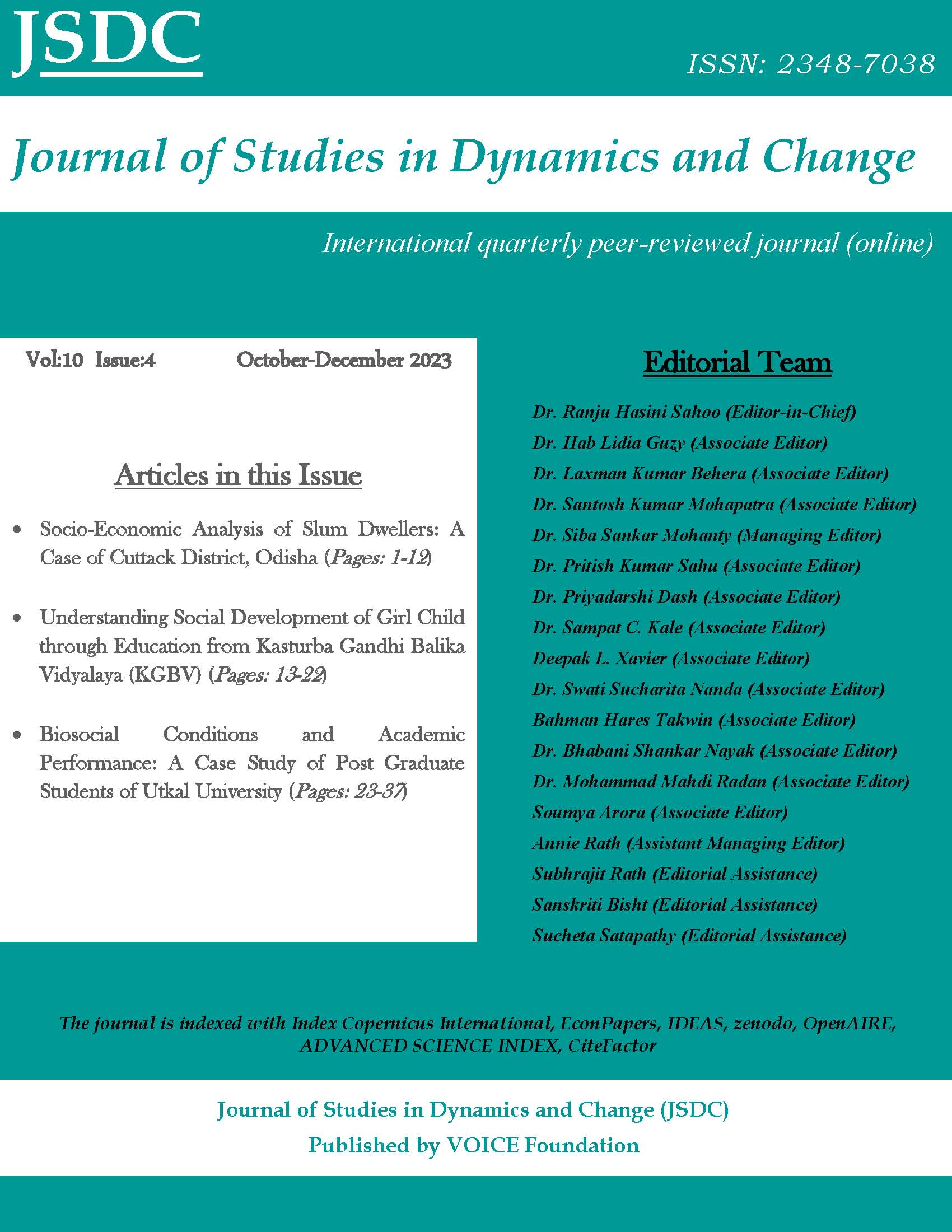Understanding Social development of girl child through education from Kasturba Gandhi Balika Vidyalaya (KGBV)
Keywords:
girl child, education, aspiration, satisfaction, social developmentAbstract
Democratic India with her constitutional commitments had targeted to offer justice to the marginalized sections through welfare measures and development initiatives. Education is one of the major sectors to bring social transformation. Among the excluded and deprived social groups, the condition of the girl child remained always worse than the boys. Education can bring greater participation of women in family, social, economic and political matters. The paradigm of social development is well achieved through education. It is commonly said that teaching a woman means teaching a family, so by educating women, we can propel society towards development. The Kasturba Gandhi Balika Vidyalaya (KGBV) scheme is a step forward in this direction. The immense potential of the scheme helps in recovering the losses that girls faced in being pushed out of formal schools due to multiple reasons. The implication of this scheme is to provide a second chance for dropout girls to explore their possibilities towards empowerment. Primary data from a KGBV in the Deogarh district of Odisha was collected for the study. The present study thus is an attempt to focus on how KGBV brings on social development among girl children. It is found that girls debarred from education due to distance from school had been brought to the educational fold following the selection criteria of KGBV, and are satisfied with the facilities provided in the KGBV. Satisfaction helps in building their aspirations for the future which contributes to their process for social development.
References
Abdulraheem, A. (2011). Education for the Economically and Social Disadvantaged Groups in India: An Assessment. Economic Affairs, 56(2), June, 233-242.
Bagh, S. (2015). Education in the ear of Market Economy: Consequences and Challenges. Man & Development, XXXVII(2), Chandigarh: Centre For Research in Rural and Industrial Development, 87-102.
Behera, Amulya (2015). Primary Education among the Tribal People of Mayurbhanj District of Odisha: an Evaluate Study. International Journal of humanities and Social Science Invention, 4(2), 43-54.
Benjamin, J. (1991). Social Mobility among the Scheduled Castes in Bihar: A Case Study of Barh Block. Social Action, 41(4), 442-453.
Brar, L., et al. (2013). Gender Equity In education: How Far Have We Reached?. The Eastern Anthropologist, 66(4), New Delhi: Serials Publications, 417- 434.
Cheney, G, R., et al. (2005). India Education Report: India Education Profile. Retrieved from http://www.ncee.org/wp-content/uploads/2013/10/ India-Education-Report.pdf/
Chitnis, S. (1975). Education of Scheduled Castes. Journal of Higher Education, 1(2), 167-178.
Das, Atal Bihari (2009). Status of Education of Scheduled Tribes in KBK Districts of Orissa. Orissa Review, October, 38-50.
Dey, A. (2015). Educational Attainment and Gender Inequality in labour market: The paradox of women’s employment in India. Man & Development, XXXVII(4), Chandigarh: Centre For Research in Rural and Industrial Development, 27-42.
Directorate of Secondary Education. Achievements/Progress under Samagra Shiksha (Elementary) & KGBV. Retrieved from https://dseodisha.in
Gandhi, M. (2015). Problems of Education Among SCs, STs, BCs and Minority Children: Opportunities And Challenges. Man In India, 95(4). New Delhi: Serials Publications (p) Ltd, 951-1003.
Ghose, B, N. (2009). Problems of Education of Scheduled Tribes and Scheduled Castes: A Case Study in Calcutta and Surroundings and Medinipur and Surrounding Areas. Vanyajati, VII (3), 28-35.
Govt. of Odisha (2012). Statistical Abstract of Odisha 2012. Directorate of Economics and Statistics Odisha, Bhubaneswar.
Gupta, S, K. (2014). Educational Transformation in India. The Eastern Anthropologist, 67(1-2), New Delhi: Serials Publications, 125-140.
Jain, L, C. (1981). Emancipation of Scheduled Castes and Tribes: Some Suggestions. Economic and Political Weekly,16(9), 325-332.
Jha, M. and Jhingram, D. (2002). Elementary Education for the poorest and other Deprived Groups. New Delhi: Centre for Policy Research.
Kirpal, V. (1978). Higher Education for the Scheduled Castes and Scheduled Tribes. Economic and Political Weekly,13(4-5), 165, 167-169.
Kumar, K. (1983). Educational Experience of Scheduled Caste and Tribes. Economic and Political Weekly,18 (36-37), 1566-1572.
Malik, S. (1979). Social Integration of Scheduled Castes. New Delhi: Abhinav Publications.
National Council of Educational Research and Training. National Consultation of Kasturba Gandhi Balika Vidyalaya. Retrieved from http: //www.ncert.nic.in/html/pdf/announcement.pdf/
Odisha School Education Programme Authority. Status of Secondary Education in Odisha. Retrieved from https://osepa.odisha.gov.in
Singh, P. (1989). Problem of Education among Scheduled Castes. New Delhi: Mittal Publications.
Singh, S. and Ohri, J. (1993). Status of tribal Women in India. Social Change, December, 23(4), 21-26.
Sujatha, K. (2002). Education Among Scheduled Tribes, in Govinda, R. (ed.), India Education Report: A Profile of Basic Education, New Delhi: Oxford University Press.
Downloads
Published
How to Cite
Issue
Section
License
Copyright (c) 2024 Journal of Studies in Dynamics and Change (JSDC)

This work is licensed under a Creative Commons Attribution-NonCommercial-ShareAlike 4.0 International License.
Readers and users of the Journal of Studies in Dynamics and Change (JSDC) are free to Share — copy and redistribute the papers published in the journal in any medium or format. However, the user (1) must give appropriate credit, provide a link to the license, and indicate if changes were made. (2) May not use the material for commercial purposes (3) Must distribute your contributions under the same license as the original if any remix, transform, or build upon the material is done.


